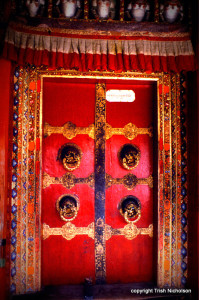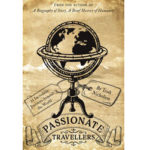 These last five topics – theme, structure, beginnings/endings, voice, and detail – are closely related. Blend them like an exquisite curry and your travelogue will be as tasty and memorable.
These last five topics – theme, structure, beginnings/endings, voice, and detail – are closely related. Blend them like an exquisite curry and your travelogue will be as tasty and memorable.
Theme
A theme – an idea or perspective that creates a pattern through the weave of your travelogue – gives it focus and purpose, and provides a backdrop against which to display your experiences. In an article, it provides you with your slant – the angle from which you approach the location – and the rationale to decide what to put in and leave out.
Your choice of theme will depend where you travel and what you do there. Here are some possibilities: local history; food; a trek or trail, as I used in Journey in Bhutan; political conflict as in Rory Stewart’s The Places in Between, based on his travel across war-torn Afghanistan, or a personal quest as in Tim Flannery’s search for unknown mammal species in Papua New Guinea, described in Throwim Way Leg.
Structure
The form, or framework: how you display your story; the order of events, and their causes and effects with which you divide a travelogue into chapters, or an article into paragraphs. It provides a route for your readers to follow, and allows for the inclusion of suspense and intrigue in the sequenced revelation of your travel story. If the experience of travelling itself is the key feature, it may be a simple chronology, but ‘Day 1’ followed by ‘Day 2’is unlikely to grab and hold a reader’s attention.
Structure is related to theme in that an account of a trek, for example, obviously follows the route of the trail for at least that part of the travelogue. Other themes offer a range of creative possibilities: for an historical theme you could start with ‘modern’ and work backwards, or vice versa; if your location includes a major river system, start at the estuary and work towards the source; from a mountain summit to the valley, or from urban to rural. Be creative, but make sure it fits with your theme and material; it needs to have some logic and be easy for readers to follow.
In Homage to Barcelona, Colm Tóibín writes separate chapters on events, e.g. the Civil War; activities (‘Food and Sex’); places, and famous local people (Gaudi, Miro, Picasso), but the overarching structure of the book is chronological, from Gothic to modernity.
Beginnings and endings (and resolution)
As I suggested in Part 1: start with a hook. The anticipation in booking your tickets, cramming another pair of socks into the suitcase, and cancelling the milk may excite you, but is unlikely to thrill your readers, so start with a dramatic arrival, or your first climax, and weave in the back-story of why or how you got there, focusing on highlights. Similarly, the most satisfying endings close on a relative high. We don’t want to follow you all the way back home, dragging luggage up three flights of stairs to your flat to share your jet lag – or the pile of bills on the mat.
“The minibus is already parked at the front, loaded with our luggage; we will leave when the dancing is over.
I think this is the last dance; they wear fearsome dragon masks, prancing and gyrating with incredible energy, eight of them, weaving about in circles, the music raucous and strident, cymbals crashing.
Ngawang will come with us, of course, retracing our steps along that tortuous road to Phuntsholing where we will stay tonight, then the long drive through Darjeeling to Siliguri, and finally to the airport at Bagdogra. There he will leave us to take our flight to Delhi. But I have decided to end my journal here, by the forest, with the dragons. It seems fitting: part of me cannot leave, and will stay here, returning to the mountains.” (Excerpt from Journey in Bhutan: Himalayan Trek in the Kingdom of the Thunder Dragon).
Having reminded the reader of the route we would retrace, I gave no other description of that long return journey, except for the steep, muddy scramble on foot to avoid a landslide that blocked the road to Phuntsholing.
In The Old Patagonian Express, Paul Theroux surveys the vast space of Patagonia, his final destination, leaving us with two sentences: “The nothingness itself, a beginning for some intrepid traveller, was an ending for me. I had arrived in Patagonia, and I laughed when I remembered I had come here from Boston, on the subway train that people took to work.”
A resolution may be included in your ending: a reference to a previously stated mission now accomplished – or not; what finally happens to a key character in your account, or an indication of a new direction for people you met or for yourself – closure can sometimes be an opening, a revolving door.
Voice
Your writing voice emerges from your whole character and personality: how and what you think and feel. Revealed not only in what you choose to write about, but in the style of writing: choice of words, their arrangement into sentences, and the viewpoint from which you write. Travel is generally written from a first person point of view – using ‘I’ or ‘we’ – because it relates personal observation, and most often in the past tense, telling the reader what has already taken place, which also enables the use of hindsight.
Writing convincingly in the present tense is much more difficult, but it gives a sense of immediacy: it is happening right now and the reader can share that freshness of experience with you. But you can achieve the best of both. In Journey in Bhutan I wrote in the present tense, alternating with extracts from my journal – recorded at the end of each day in the past tense – to allow me to reflect on events.
Detail
It is the small facts and details that resonate with readers and give authenticity to travel writing. Walking around a local market, for example, simply describing local craft, art or food, however colourful and attractive, is less inspiring now that we see so many of these fabrics and foods in our own shops and restaurants. Take us into a local kitchen to see how they make samosas. Better still: let us share your messy attempts at making them yourself. Or, like Frances Mayes in Bella Tuscany, quote some local recipes.
Tell us about the weavers and their traditional patterns:
“Only women weave; it’s an important source of household income. Some still spin wool, but most buy skeins of yarn. She had a huge range of colours and patterns, some quite plain with small motifs or narrow stripes, others in broad red and yellow strips, busy with additional designs woven into the colours. Various patterns and weaves are associated with different regions and have specific names; the more elaborate and colourful weaves are worn for ‘best’ on festive occasions.” (Journey in Bhutan).
Overview of the series
 Examples of travel writing tips from all three parts of this series can be found in my latest travel narrative: Passionate Travellers: Around the World on 21 Incredible Journeys in History – journeys through deserts, mountains, jungles and seas to every continent, spanning 2000 years of history. These are true tales of daring adventure. courage, cunning, even murder and, above all, sheer determinati0n against all odds.
Examples of travel writing tips from all three parts of this series can be found in my latest travel narrative: Passionate Travellers: Around the World on 21 Incredible Journeys in History – journeys through deserts, mountains, jungles and seas to every continent, spanning 2000 years of history. These are true tales of daring adventure. courage, cunning, even murder and, above all, sheer determinati0n against all odds.
I hope you have found these tips useful. For much more advice on travel writing, including how to choose a publishing option and to market your book, see: Writing Your Nonfiction Book: the complete guide to becoming an author, also available as an ebook from your favourite online store.
If you enjoy reading about travel and adventure in exotic places, you’ll love these illustrated travelogues:
Journey in Bhutan: Himalayan Trek in the Kingdom of the Thunder Dragon, (Ebook only)
Inside the Crocodile: The Papua New Guinea Journals (also available as an ebook)
And do take a video mini trip to Papua New Guinea on the Home Page.

These posts have been really useful – thank you, Trish.
I think theme is critical – it’s the bit that has caused me the biggest headache with the Laos trip – it’s what elevates travel writing beyond the ‘I did this, I did that …’ but some countries are more difficult to ‘get hold of’ than others. (It will, soon, be an ebook, so then I’ll know if I’ve managed to extricate a theme from the chaos of my notebooks!)
Hi Jo, thanks for your comments here, and I see I missed your comment last week. I agree about theme – it’s the same with short stories of course – best of luck with your writing.